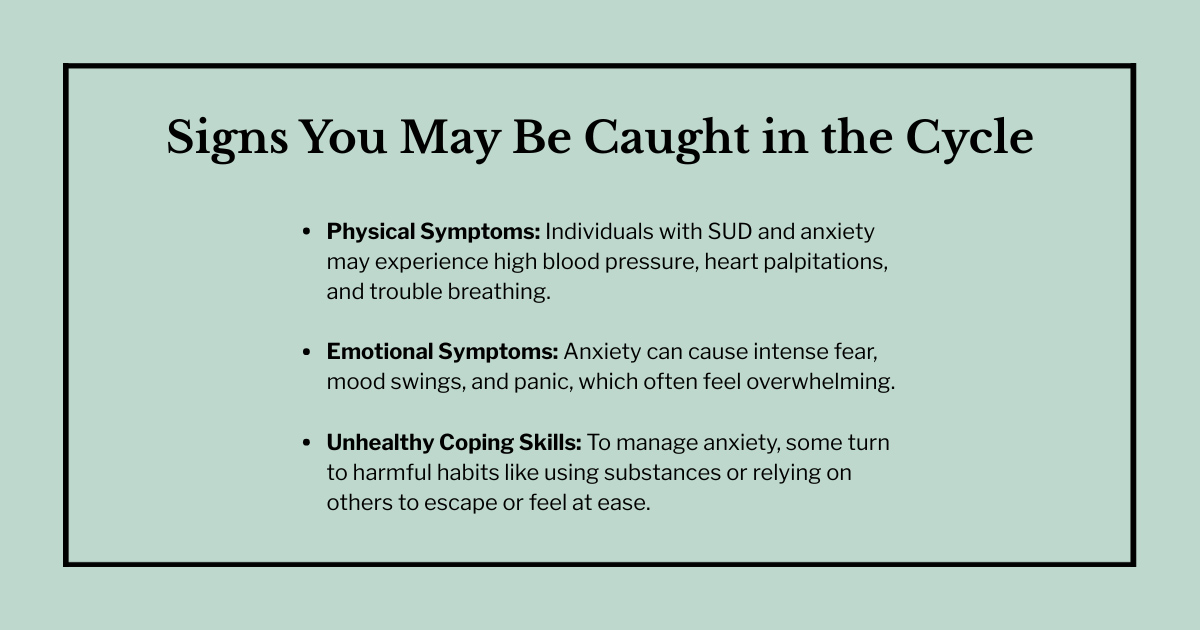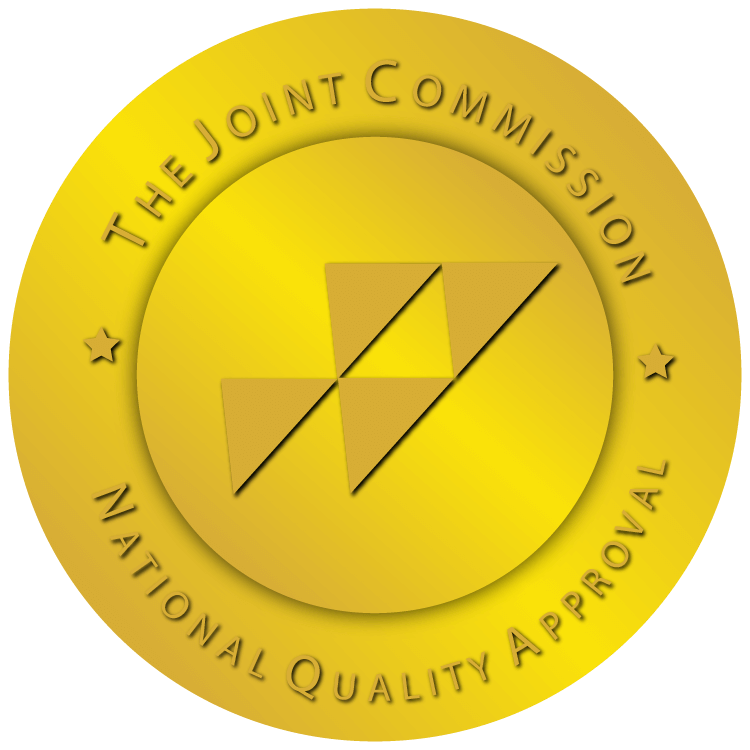
Anxiety disorders and substance use are often connected, so much so that it can be hard to determine which began first. When a mental health disorder like persistent anxiety and a substance use disorder occur at the same time, they are referred to as co-occurring disorders. Co-occurring disorders like these can exacerbate one another, as individuals with anxiety may experience strong urges to numb those feelings with substances. In contrast, substance use can increase feelings of helplessness and unease.
Together, these conditions can create a vicious cycle that can be nearly impossible to handle without professional help. In addition, the subtypes of anxiety, like panic disorder and social anxiety disorder, require carefully-chosen strategies to address. See if you may be experiencing anxiety by taking our Anxiety Quiz. Then, read on to learn more about anxiety, addiction, potential treatment options, and more, or browse our Causes of Anxiety Infographic.
The Connection Between Anxiety and Addiction
Anxiety can be debilitating, so it is not shocking that some people who experience it turn to substance use as a form of self-medication. Without treatment to learn healthy coping skills, using substances such as drugs and alcohol to numb the symptoms of anxiety can lead to a long-term dependence on the substance of choice. Eventually, a persistent pattern of substance use that persists despite increasingly negative consequences can emerge – a hallmark of substance use disorders.
As mentioned, disordered substance use can contribute to anxiety, too. Even though the alcohol or drugs may have initially numbed feelings of anxiety, continuous use and the negative circumstances it can cause can worsen the symptoms of anxiety. A longitudinal survey published by the National Institute on Alcohol Abuse and Alcoholism discovered that not only did self-medication increase the instances of new substance use disorders in people with anxiety, but it also increased instances of anxiety. (Robinson, et al, 2011) As you can see, anxiety and substance use can seem inextricably linked, creating a vicious cycle that is difficult to escape.
Put another way, the cycle of substance use and anxiety is a pattern formed when an individual experiences anxiety and tries to numb or block out the source or symptoms of anxiety. Avoiding anxiety can provide temporary relief, but as the individual has not learned how to cope with anxiety symptoms or deal with stressors, both will persist once intoxication wears off. The return of anxiety can increase the desire to use substances, and substance use can create negative impacts that can increase anxiety.
Impacts of Anxiety
Persistent anxiety can impact both physical and mental health. The nervous system, in particular, is affected by anxiety.
Brain chemicals called neurotransmitters act as a messaging system to send signals between nerve cells and both brain and body cells. One important neurotransmitter, gamma-aminobutyric acid (GABA), can contribute to anxiety when there is a decrease in activity, as it helps regulate activity in the brain to combat mental issues such as depression, insomnia, and anxiety. Another inhibitory neurotransmitter, serotonin, helps regulate moods, sleep, and more. The National Institute on Drug Abuse (NIDA, 2020) reports that when substances like drugs and alcohol continuously disrupt normal neurotransmitter function, mental health disorders like persistent anxiety can occur.
Dopamine is a particularly relevant neurotransmitter, as it is crucial to the brain’s natural reward system. Increases in dopamine can result in feelings of pleasure, which ultimately affect sleep, mood, and the ability to focus. Unfortunately, research in the Journal of Neuroscience (Berry Et al, 2019) describes how dopamine is also linked to anxiety, fear, and even paranoia. This means that the frequent dopamine fluctuations initially experienced by people using drugs or alcohol can eventually worsen anxiety instead of numbing it.
The Importance of Dual Diagnosis Treatment

As mentioned, co-occurring disorders refer to an individual experiencing two separate physical or mental health conditions at the same time. Anxiety and substance use disorders are often co-occurring, which means that the individual is struggling with a substance use disorder and a mental health disorder at the same time. As anxiety and substance use disorders are difficult to handle separately, this so-called “dual diagnosis” can be overwhelming and extremely challenging to overcome without help.
In fact, anxiety and substance use disorders are frequently interlinked and can exacerbate one another. For most people with this dual diagnosis, it is essential to seek treatment for both conditions at the same time because one condition influences the other. As there is no one-size-fits-all treatment for this dual diagnosis, a personalized treatment program that incorporates anxiety and mental health therapies as well as substance use disorder treatment is key for recovery.
This is not to say that challenges do not exist for people who need to treat anxiety and substance use disorders. For example, some people experience difficulty determining which condition started first and which condition to prioritize. Although SUD is twice as prevalent in adults who have a mental health condition, according to a study published in Addiction Science & Clinical Practice (Gould, 2010), it can be next to impossible to tell which condition is at the root of the issue.
Overlapping symptoms are another common challenge of this dual diagnosis. Symptoms associated with anxiety, such as mood swings, difficulty focusing, and restlessness, are also symptoms of substance use. Likewise, an SUD can also look like an anxiety disorder. Misdiagnosis can result in a delay in treatment or even unnecessary treatment.
For these reasons, it is crucial to seek treatment that can not only identify anxiety and SUD but also address both. Doing so can treat both sets of symptoms, their root cause, and the negative effects caused when they interact.
Maryland Recovery offers dual diagnosis support via mental health professionals who can provide both medication management and therapy.
Types of Anxiety Disorders That Commonly Co-Occur With Substance Use
Anxiety disorders are far more complex than occasional feelings of unease and tension.
These unique anxiety disorders are often linked to substance use disorders:
- Generalized Anxiety Disorder – Generalized Anxiety Disorder, or GAD, involves persistent anxiety over small, everyday things. GAD can affect daily life by interfering with a person’s ability to focus on work, keep up with their relationships, or pursue activities that improve quality of life.
- Panic Disorders – Panic disorders are another kind of anxiety disorder that can cause sudden panic attacks with symptoms that may feel like a heart attack, including a racing heartbeat and difficulty breathing. People with panic disorders often live in constant fear of another attack.
- Social Anxiety Disorder – This is an anxiety disorder where the individual fears the judgment of others while also feeling very self-conscious of themselves, even in everyday circumstances. The fear of others is so debilitating that people with SAD may even avoid going out in public or meeting new people, impacting their work and school performance as well as their ability to make or keep friendships.
- Agoraphobia – Agoraphobia is the fear of situations or places that causes fear, panic, helplessness, embarrassment, and entrapment. Often, trauma can result in a fear of being caught in a situation that triggers anxiety, causing the individual to react out of fear.
Anxiety disorders can be extremely difficult to handle on your own, especially when linked with substance use. For more information, visit our Anxiety Disorders Resource Page.
Agoraphobia, Codependency, and Substance Abuse
As defined by the National Institute of Mental Health, agoraphobia is an intense fear and anxiety of any place or situation in which escape may be difficult. (National Institute of Mental Health, 2025) As a result of this extreme fear, a person who suffers from this anxiety disorder may avoid taking public transportation, experiencing crowds, or being alone anywhere outside of their home.
All too often, people experiment with substance use as a way to self-medicate and calm some of the fear and panic that results from these situations. Substances can also be a way to manage anxiety-inducing situations, in hopes of remaining calm enough to take part in something that would otherwise trigger a panic attack. However, substances are not the only form of self-medication used by individuals with anxiety; even other people can serve as a means of avoiding anxiety, especially for those who have developed an SUD.
Codependency is a state where a person becomes emotionally and psychologically reliant on a partner to find their self-worth, approval, and identity. Codependency can be especially apparent in situations where a person has an anxiety disorder. If they become codependent on a partner to be with them in uncomfortable situations, anxiety and panic can result when the partner is not available. As these feelings increase, other, even less healthy, methods of coping (like drugs and alcohol) can result.
Signs You May Be Caught in the Cycle

Do you suspect you may be caught in the cycle of anxiety and substance use?
Look for these signs:
- Physical Symptoms – People experiencing SUD and anxiety often notice hypertension, heart palpitations, and difficulty breathing.
- Emotional Symptoms – Emotional symptoms can be especially debilitating and include fear, mood swings, and panic.
- Unhealthy Coping Skills – Many people develop unhealthy coping patterns as a way to avoid feelings of anxiety, such as using people, alcohol, and/or drugs to help calm their nerves, relax, or escape.
While avoiding the triggers that cause anxiety can provide a sense of relief, it is only temporary. Over time, people who rely on unhealthy coping skills and social avoidance must do so more often as they build up a tolerance. This means more of the substance is necessary to achieve the same relief. Worse, if you are truly mired in the cycle of anxiety and substance use, you may also find yourself having trouble functioning without substances.
Hope for Recovery: Effective Treatment for Anxiety and Addiction
Because anxiety and addiction can and will exacerbate one another, treating both issues is essential to avoid relapse. Integrated dual diagnosis care is essential for recovery.
Such care should incorporate a personalized treatment plan that includes multiple strategies to address both conditions.
- Cognitive Behavioral Therapy (CBT) – This kind of therapy helps individuals understand their unhealthy behaviors and patterns of thought and how they relate to their anxiety.
- Dialectical Behavior Therapy (DBT) – This type of psychotherapy helps individuals with anxiety understand the harmful thoughts that cause their anxiety while helping them regulate emotions and develop healthy coping skills.
- Eye Movement Desensitization and Reprocessing (EMDR) – This therapy helps individuals remember traumatic events while utilizing bilateral stimulation to help process trauma and desensitize triggering memories.
- Trauma-Informed Care – While not a treatment modality, trauma-informed care describes all care that attempts to understand the impact that trauma has on a person’s emotional, mental, and physical state. Trauma-informed care focuses on encouraging the individual to make their own choices and take charge of their life.
- Medication Management – This is not a treatment modality but a service provided in dual diagnosis treatment. The term refers to prescribing and administering medications in a way that is safe for the individual to prevent errors, adverse effects, or overdoses.
- Peer Support and Holistic Practices – People who need treatment for anxiety and SUD can benefit from connecting with other individuals with similar experiences. Similarly, holistic practices offered by treatment providers, such as yoga and mindfulness training, can provide valuable coping skills during recovery.
At Maryland Recovery, we understand the importance of treating both aspects of a dual diagnosis concurrently. Our SUD treatment programs focus on treating anxiety and substance use together.
Tips to Reduce Anxiety Without Substances
Whether you are experiencing SUD alongside anxiety or simply looking for healthier ways to cope with stress, these practices can help you reduce your symptoms of anxiety without harmful substance use.
- Exercise – Exercising regularly is an excellent way to minimize stress as the body releases endorphins, creating a natural mood boost. Even if you aren’t interested in going to the gym, taking part in an activity that gets the heart pumping for 30 minutes three times a week can have positive physical and mental health effects.
- Meditation and Mindfulness – These practices can help you recognize your anxious thoughts without reacting to them. You can learn how to breathe through the anxiety using breathing techniques and take part in other holistic practices, such as yoga.
- Journaling – Writing your thoughts in a journal is also helpful as it gives you a space to express your fears and anxiety without judgment. You can also write down positive things to help combat the negative thoughts.
- Other Stress Reduction Techniques – Stress reduction is a key component of recovery. When you establish healthy routines, you are less likely to feel stressed and have less space to seek harmful substances.
How Maryland Recovery Can Help

At Maryland Recovery, we know how crucial it is to address both components of a dual diagnosis during treatment. Treating one condition without treating the other only perpetuates the cycle and can lead to a relapse. As such, we offer dual diagnosis support for those searching for long-term healing and recovery.
Some of the options available at Maryland Recovery include:
- Individual and group therapy
- Peer support opportunities
- Meditation and mindfulness training
- Life skills coaching
- Personalized 12-step recovery programs
- Access to licensed internal and external mental healthcare providers
Begin your journey to recovery by taking the first steps that are right for you. Discover whether you are struggling with anxiety by taking our Anxiety Quiz, and begin understanding your own patterns. Or, seek additional information about anxiety and Explore Anxiety Resources.
Although struggling with addiction and anxiety can feel overwhelming, healing is possible. Reaching out for help and support is essential to beginning your journey to recovery. For treatment options, contact Maryland Recovery today.
*This post was updated for accuracy and clarity in June 2025. It combines and expands on several earlier blog posts to better reflect what we now know about co-occurring anxiety and substance use disorders. — Maryland Recovery Editorial Team
Sources:
- Volkow, N. D., Koob, G. F., & McLellan, A. T. (2016). Neurobiologic advances from the brain disease model of addiction. JAMA Psychiatry, 73(7), 719–728. https://jamanetwork.com/journals/jamapsychiatry/fullarticle/1107248
- National Institute on Drug Abuse. (2020, July). Drugs, brains, and behavior: The science of addiction – Drugs and the brain. https://nida.nih.gov/publications/drugs-brains-behavior-science-addiction/drugs-brain
- Lüscher, C., Robbins, T. W., & Everitt, B. J. (2019). The transition to compulsion in addiction. The Journal of Neuroscience, 39(14), 2735–2745. https://www.jneurosci.org/content/39/14/2735
- Volkow, N. D., & Baler, R. D. (2011). Addiction science: Uncovering neurobiological complexity. Neuropharmacology, 56(Suppl 1), 3–7. https://www.ncbi.nlm.nih.gov/pmc/articles/PMC3120118/
- National Institute of Mental Health. (n.d.). Agoraphobia. Retrieved March 27, 2025, from https://www.nimh.nih.gov/health/statistics/agoraphobia

A solution focused therapist with over a decade in the helping services, I am attuned to the broad expanse of holistic recovery. My mission is inspired by the work of Joseph Campbell, Dr. Wayne Dyer, and Fr. Joseph Martin. I am well versed in the specific needs of the recovery community and am trained in EMDR.








